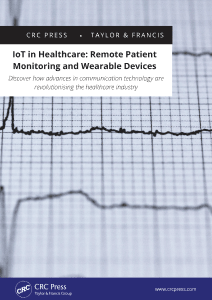IoT in Healthcare and Advances in Remote Patient Monitoring
Posted on: November 12, 2019
A very simple definition of IoT is ‘anything, anytime, anywhere’. IoT in healthcare has played a prominent role in the redesigning of present systems with the current advancements in the field of technology associated with IoT. IoT based solutions guarantee health monitoring not only in hospitals and house environment, but also in outdoor environments.

Advantages of IoT in Healthcare
IoT start-ups are finding new implementations within healthcare and are leveraging connected sensors for better diagnoses, monitoring and guiding patient treatment. The major advantages of the IoT in healthcare are the following:
- Reduces costs of medical treatment
- Betters outcomes of treatment
- Better diseases management and reduced errors
- Improves patient experience
- Upgrades management of drugs
.png)
Internet of Medical Things (IoMT)
The IoMT is playing a pivotal role in remote healthcare and monitoring to increase the efficacy of medical devices, and the speed and accessibility of medical services. It can be used to collect remote patient health data utilizing wearable sensors and devices connected to Internet-based health monitoring systems.
The concept of IoMT is the integration of healthcare devices with computer networks through the web, which receives information in real time, and also allows interaction with patients. Basically, IoMT associates living and non-living things through the web.
The IoMT is able to remotely connect people about chronic diseases by using the patients’ and hospitals’ locations and tracking medication orders and wearable health devices. It enables faster diagnosis of disease and decision-making by compiling numerous medical data (i.e. big data) on time coupled with wise investigation.
.png)
Internet of Nanotechnology (IoNT)
Nanotechnology has gained a lot of attention in recent times due to rapid increases in the field of technology, especially towards miniaturization of embedded hardware devices.
A nano-sensor in the medical field can be defined as any sensor capable of detecting nanoparticles. Nano-sensors are also capable of monitoring the physical and biological parameters at nano scale. Nano-sensors can be used in the field of healthcare for remote monitoring of any individual who has wearable sensors capable of detecting and monitoring vital parameters. Each of these nano-sensors can communicate with a smartphone over the air either through a low energy Bluetooth or any other RF communicative device (or even it may be a wired connection). A central server can be established governing, storing and controlling the complete architecture of the system. Communication to the central server is with a smartphone on the patient side, and with the router on the hospital side, which will be completely wireless. Here a central server will also have an online portal displaying the complete profile of the data measured/detected or monitored by the nano-sensors, and it will also have the feedback/prescription or suggestion given by the medical representative from the hospital side. IoT in healthcare will fulfil all the requirements needed for the establishment, control and supervision required for the online portal.
|




